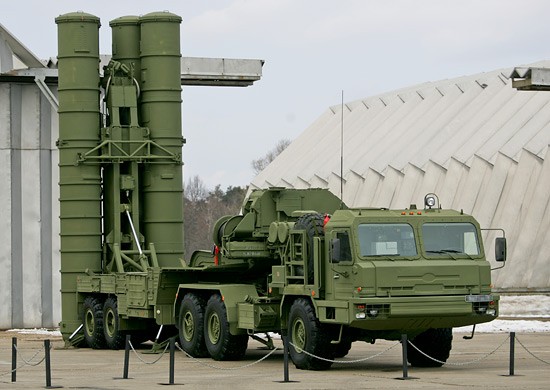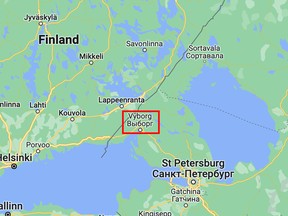Russia: No nuclear-free status for the Baltic
"Russia has earlier indicated that it is placing for example these S-400 anti-aircraft missiles in the Kola Peninsula, and it has earlier said it’s placing these missiles in Crimea.""This is normal practice. Russia is using these systems to replace the older S-300 rockets.""The reporting was a bit surprising. There was a tinge of foreign policy in the Moscow Times piece that cited President Putin’s comments on (potential Finnish membership of) NATO.""The positioning of S-400 Triumf missiles near Saint Petersburg is evidence that Saint Petersburg is an important metropolis for Russia."Finnish Defence Minister Jussi Niinistö
 |
| Russian Iskander-M missile launcher on display during Victory Day parade Photograph:( AFP |
A convoy is shown on a video obtained by Reuters,
comprised of over a dozen military vehicles, some thought to be
carrying Iskander missiles en route to Vyborg, a Russian city adjacent
the border with Finland.The deputy chairman of Russia's Security
Council, Dmitry Medvedev -- a close colleague of Vladimir Putin who once
played musical chairs with Putin, occupying the presidency while the
prime ministership was temporarily taken by Putin in a bid to return to
the presidency legally under the Russian constitution which he later
manipulated to make it legal for him to continue as President -- warned
should Finland and Sweden join NATO, Russia would undertake to move
nuclear weapons closer to the two countries whose move to join NATO the
Kremlin viewed as threatening.
"There can be no more talk of our nuclear-free status for the Baltic", he remarked on April 14.
Traditionally
neutral, Finland and Sweden decided to break with that Cold War
convention, in favour of defending themselves against a neighbour whose
moves of aggression could be anticipated on the basis of the example
before the eyes of the world, where Ukraine is now in active conflict
forced upon it by Moscow's 'special military operation'. Neither Finland
nor Sweden have any aspirations to test their own military's mettle
facing off against a potential Russian invasion without an additional
bit of defence; the combined strength of the North Atlantic Treaty
Organization.
This
represents somewhat of a miscalculation on the part of Vladimir Putin,
consumed with rage over NATO expansion within the Russian Federation's
'near abroad', taunting Moscow as it were, with its
too-close-for-comfort presence. An already-suspicious Putin arrived to a
state of paranoia, a state which possibly inured him to the kind of
introspection that might have warned him that he would be risking a
great deal by launching into a conflict with Ukraine whose reaction to
being occupied on a larger scale than the Donbas was obviously
underestimated.
 | |
| Vladimir Putin chairs a meeting via teleconference on May 17. EPA |
The
scenario that Mr. Putin envisioned and was intent on forestalling, was
in fact accelerated by his very actions in bringing war to Ukraine with
its burden of civilian and military deaths, destroyed cities, millions
of displaced homeless and refugees and Russia's own massive losses in
dead commanders as well as servicemen, and the destruction of war
machines resulting from Ukrainian defence and bold counter-attacks. The
missiles were reportedly parked inside Russia's borders next to Ukraine
before the February24 invasion before the decision was made to move them
at this juncture.
Now
that NATO acceptance of Finland and Sweden is assured, Mr. Putin finds
it useful to move the nuclear-capable-warhead missiles to locations
close to its borders with Finland. Finland appears to be calmly
assessing the situation, finding nothing too much out of the ordinary by
the move taken by its mercurial neighbour. And taking it all in stride
as far as its reaction can be seen and analyzed by the outside world
looking in. What is being discussed and analyzed within Finland in the
security of government and military chambers may be another story.
 |
| S-400 Triump is an anti-aircraft weapon system. Photo: mil.ru |
From
NATO's perspective, the organization stands to gain by taking Finland
and Sweden under its protective wing in the sense that they would become
instant "net contributors" to European security. The two countries'
absorption into the group would simplify defence of NATO's Baltic
members, increasing the alliance's borders with Russia with the addition
of 1,900 kilometers representing the border between Russia and Finland.
Turkey,
which has long since become a liability politically within NATO,
balanced against the immense size of its military, is the fly in the
ointment with Recep Tayyip Erdogan threatening to weigh in against their
accession. The Nordic countries, demands Ankara, must stop its support
for Kurdish militant groups on their soil. Their bans on arms sales to
Turkey must also be lifted. This, from a NATO member-country which
contracted the purchase of Russian weapons for its military, disrupting
the interoperability of NATO member groups' military hardware.

Labels: Finland, NATO Membership, Nuclear Warhead-carrying Missiles, Russian Invasion of Ukraine Fallout, Sweden

<< Home